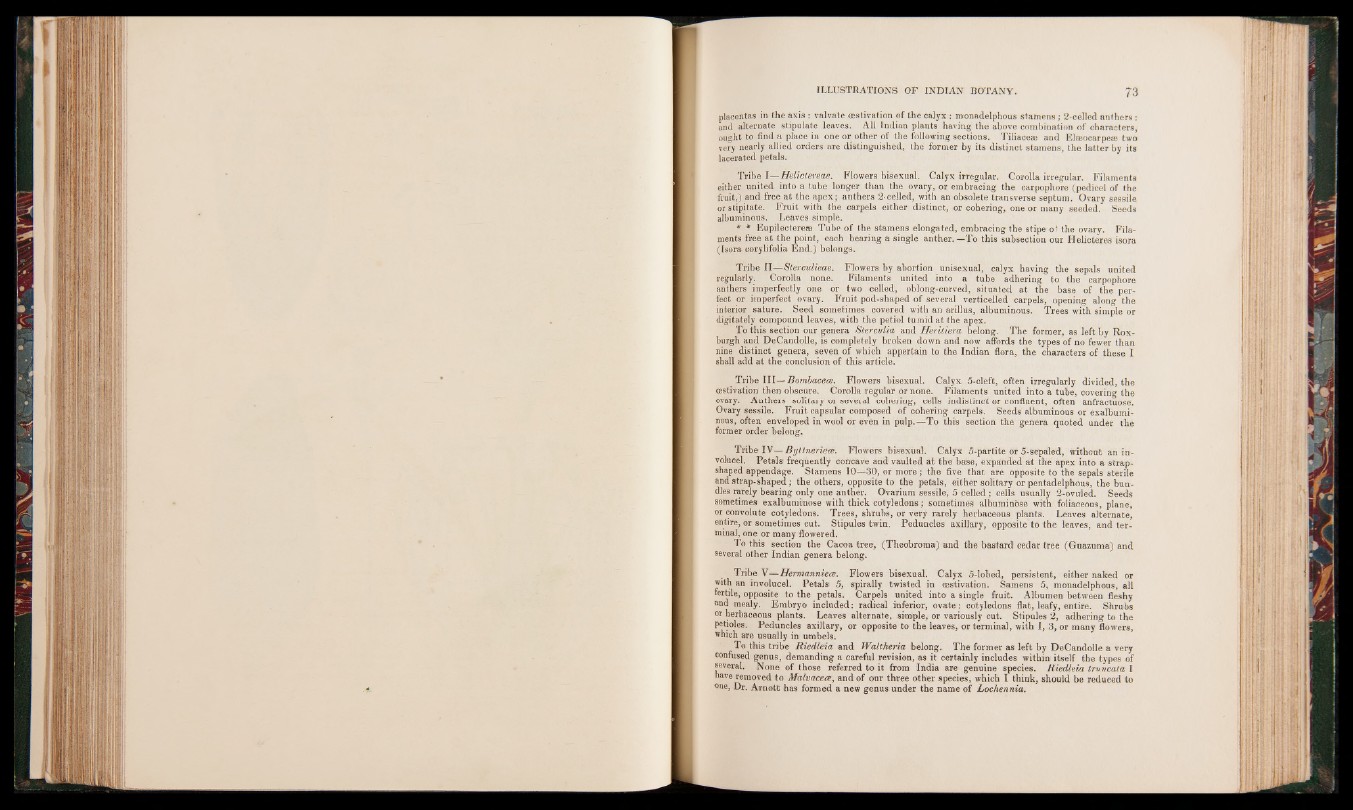
placentas in the axis : valvate oestivation of the calyx : monadelphous stamens ; 2-celled anthers :
and alternate stipulate leaves. All Indian plants having the above combination of characters,
ought to find a place in one or other of the following sections. Tiliacese and Eleeocarpeee two
very nearly allied orders are distinguished, the former by its distinct stamens, the latter by its
lacerated petals.
Tribe I—Helictereae. Flowers bisexual. Calyx irregular. Corolla irregular. Filaments
either united into a tube longer than the ovary, or embracing the carpophore (pedicel of the
fruit,) and free at the apex; anthers 2-celled, with an obsolete transverse septum. Ovary sessile
or stipitate. Fruit with the carpels either distinct, or cohering, one or many seeded. Seeds
albuminous. Leaves simple.
* * Eupilectereee Tube of the stamens elongated, embracing the stipe of the ovary. Filaments
free at the point, each bearing a single anther.—To this subsection our Helicteres isora
(Isora corylifolia End.) belongs.
Tribe II—Sterculieae. Flowers by abortion unisexual, calyx having the sepals united
regularly. Corolla none. Filaments united into a tube adhering to the carpophore
anthers imperfectly one or two celled, oblong-curved, situated at the base of the perfect
or imperfect ovary. Fruit pod-shaped of several verticelled carpels, opening along the
interior sature. Seed sometimes covered with an arillus, albuminous. Trees with simple or
digitately compound leaves, with the petiol tumid at the apex.
To this section our genera Stercvlia and Heritiera belong. The former, as left by Roxburgh
and DeCandolle, is completely broken down and now affords the types of no fewer than
nine distinct genera, seven of which appertain to the Indian flora, the characters of these I
shall add at the conclusion of this article.
Tribe II I— Bombacea. Flowers bisexual. Calyx 5-cleft, often irregularly divided, the
cestivation then obscure. Corolla regular or none. Filaments united into a tube, covering the
ovary. Anthers solitary or several cohering, cells indistinct or confluent, often anfractuose.
Ovary sessile. Fruit capsular composed of cohering carpels. Seeds albuminous or exalbumi-
nous, often enveloped in wool or even in pulp.—To this section the genera quoted under the
former Order belong!.
Tribe IV— Bytlneriea. Flowers bisexual. Calyx 5-partite or 5-sepaled, without an invoked.
Petals frequently concave and vaulted at the baise, expanded at the apex into a strapshaped
appendage. Stamens 10—30, or more; the five that are opposite to the sepals sterile
and strap-shaped; the others, opposite to the petals, either solitary or pentadelphous, the bundles
rarely bearing only one anther. Ovarium sessile, 5 celled; cells usually 2-ovuled. Seeds
sometimes exalbuminose with thick cotyledons; sometimes albuminose with foliaceous, plane,
or convolute cotyledons. Trees, shrubs, or very rarely herbaceous plants. Leaves alternate,
entire, or sometimes cut. Stipules twin. Peduncles axillary, opposite to the leaves, and terminal,
one or many flowered.
To this section the Cacoa tree, (Theobroma) and the bastard cedar tree (Guazuma) and
several other Indian genera belong.
Tribe Y—Hermanniece. Flowers bisexual. Calyx 5-lobed, persistent, either naked or
with an involueel. Petals 5, spirally twisted in oestivation. Samens 5, monadelphous, all
fertile, opposite to the petals. Carpels united into a single fruit. Albumen between fleshy
and mealy. Embryo included: radical inferior, ovate: cotyledons flat, leafy, entire. Shrubs
or herbaceous plants. Leaves alternate, simple, or variously cut. Stipules 2, adhering to the
petioles. Peduncles axillary, or opposite to the leaves, or terminal, with I, 3, or many flowers,
which are usually in umbels.
To this tribe Riedleia and Waitheria belong. The former as left by DeCandolle a very
confused genus, demanding a careful revision, as it certainly includes within itself the types of
several. None of those referred to it from India are genuine species. Riedleia truncata I
have removed to Malvaceae, and of our three other species, which I think, should be reduced to
one, Dr. Arnott has formed a new genus under the name of Lochennia.